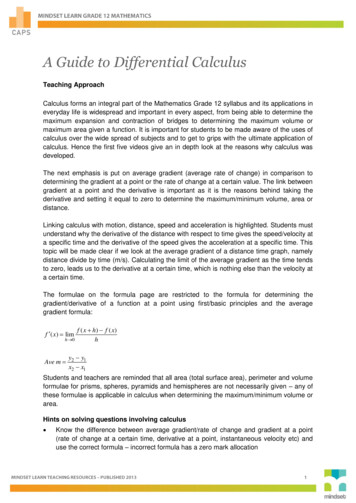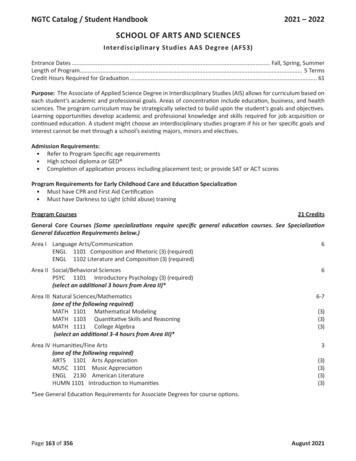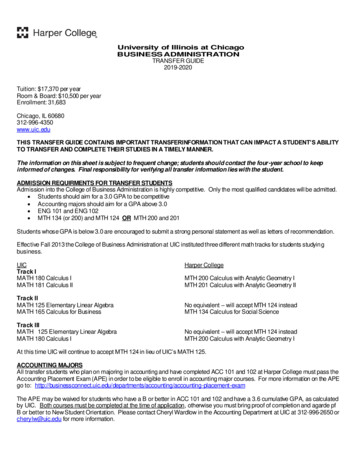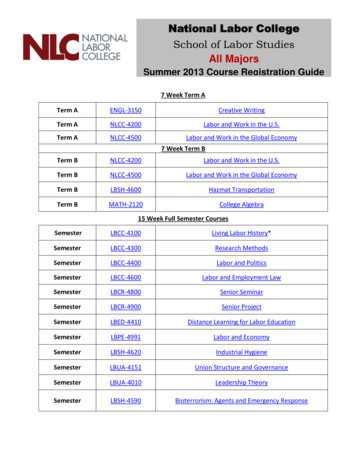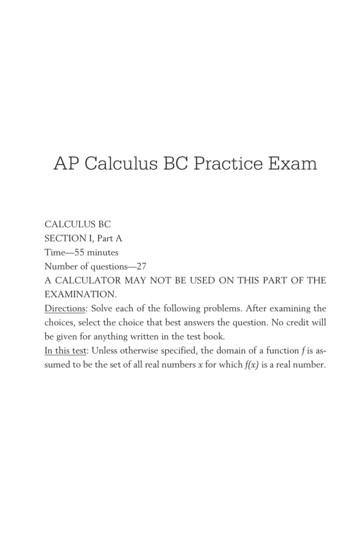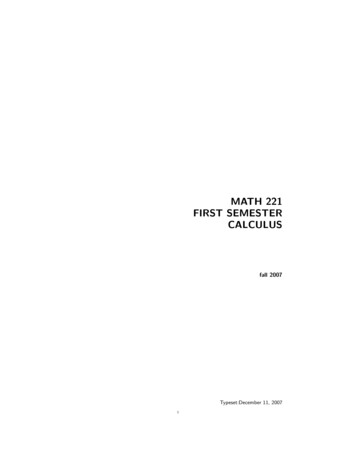
Transcription
MATH 221FIRST SEMESTERCALCULUSfall 2007Typeset:December 11, 20071
2Math 221 – 1st Semester CalculusLecture notes version 1.0 (Fall 2007)This is a self contained set of lecture notes for Math 221. The notes were written bySigurd Angenent, starting from an extensive collection of notes and problems compiled byJoel Robbin.The LATEX and Python files which were used to produce these notes are available at thefollowing web sitewww.math.wisc.edu/ angenent/Free-Lecture-NotesThey are meant to be freely available in the sense that “free software” is free. Moreprecisely:Copyright (c) 2006 Sigurd B. Angenent. Permission is granted to copy, distribute and/ormodify this document under the terms of the GNU Free Documentation License, Version 1.2or any later version published by the Free Software Foundation; with no Invariant Sections,no Front-Cover Texts, and no Back-Cover Texts. A copy of the license is included in thesection entitled ”GNU Free Documentation License”.
3ContentsI.Numbers, Points, Lines and Curves1. What is a number? Another reason to believe in 2Why are real numbers called real?Exercises2. The real number line and intervals2.1. Intervals2.2. Set notationExercises3. Sets of Points in the Plane3.1. Cartesian Coordinates3.2. Sets3.3. LinesExercises4. Functions4.1. Example: Find the domain and range of f (x) 1/x24.2. Functions in “real life”5. The graph of a function5.1. Vertical Line Property5.2. Example6. Inverse functions and Implicit functions6.1. Example6.2. Another example: domain of an implicitly defined function6.3. Example: the equation alone does not determine the function6.4. Why use implicit functions?6.5. Inverse functions6.6. Examples6.7. Inverse trigonometric 51515161616171718181919II.Derivatives (1)7. The tangent to a curve8. An example – tangent to a parabola9. Instantaneous velocity10. Rates of changeExercises212122232424III. Limits and Continuous Functions11. Informal definition of limits11.1. Example11.2. Example: substituting numbers to guess a limit11.3. Example: Substituting numbers can suggest the wrong answerExercise12. The formal, authoritative, definition of limit12.1. Show that limx 3 3x 2 1112.2. Show that limx 1 x2 112.3. Show that limx 4 1/x 1/4Exercises13. Variations on the limit theme13.1. Left and right limits25252525262626282929303030
413.2. Limits at infinity.13.3. Example – Limit of 1/x13.4. Example – Limit of 1/x (again)14. Properties of the Limit15. Examples of limit computations15.1. Find limx 2 x215.2. Try the examples 11.2 and 11.3 using the limit properties 15.3. Example – Find limx 2 x 15.4. Example – Find limx 2 x 15.5. Example – The derivative of x at x 2.15.6. Limit as x of rational functions15.7. Another example with a rational function16. When limits fail to exist16.1. The sign function near x 016.2. The example of the backward sine16.3. Trying to divide by zero using a limit16.4. Using limit properties to show a limit does not exist16.5. Limits at which don’t exist17. What’s in a name?18. Limits and Inequalities18.1. A backward cosine sandwich19. Continuity19.1. Polynomials are continuous19.2. Rational functions are continuous19.3. Some discontinuous functions19.4. How to make functions discontinuous19.5. Sandwich in a bow tie20. Substitution in Limits 20.1. Compute limx 3 x3 3x2 2Exercises21. Two Limits in TrigonometryExercisesIV. Derivatives (2)22. Derivatives Defined22.1. Other notations23. Direct computation of derivatives23.1. Example – The derivative of f (x) x2 is f 0 (x) 2x23.2. The derivative of g(x) x is g 0 (x) 123.3. The derivative of any constant function is zero23.4. Derivative of xn for n 1, 2, 3, . . .23.5. Differentiable implies Continuous23.6. Some non-differentiable functionsExercises24. The Differentiation Rules24.1. Sum, product and quotient rules24.2. Proof of the Sum Rule24.3. Proof of the Product Rule24.4. Proof of the Quotient Rule24.5. A shorter, but not quite perfect derivation of the Quotient Rule24.6. Differentiating a constant multiple of a function24.7. Picture of the Product Rule25. Differentiating powers of 3535454545555
5V.25.1. Product rule with more than one factor25.2. The Power rule25.3. The Power Rule for Negative Integer Exponents25.4. The Power Rule for Rational Exponents25.5. Derivative of xn for integer n25.6. Example – differentiate a polynomial25.7. Example – differentiate a rational function25.8. Derivative of the square rootExercises26. Higher Derivatives26.1. The derivative is a function26.2. Operator notationExercises27. Differentiating Trigonometric functionsExercises28. The Chain Rule28.1. Composition of functions28.2. A real world example28.3. Statement of the Chain Rule28.4. First example28.5. Example where you really need the Chain Rule28.6. The Power Rule and the Chain Rule28.7. The volume of a growing yeast cell28.8. A more complicated example28.9. The Chain Rule and composing more than two functionsExercises29. Implicit differentiation29.1. The recipe29.2. Dealing with equations of the form F1 (x, y) F2 (x, y)29.3. Example – Derivative of 4 1 x429.4. Another example29.5. Derivatives of Arc Sine and Arc TangentExercises on implicit differentiationExercises on rates of 656667676969696970717172Graph Sketching and Max-Min Problems30. Tangent and Normal lines to a graph31. The intermediate value theoremExample – Square root of 2Example – The equation θ sin θ π2Example – Solving 1/x 032. Finding sign changes of a function32.1. Example33. Increasing and decreasing functions34. Examples34.1. Example: the parabola y x234.2. Example: the hyperbola y 1/x34.3. Graph of a cubic function34.4. A function whose tangent turns up and down infinitely often near the origin35. Maxima and Minima35.1. Where to find local maxima and minima35.2. How to tell if a stationary point is a maximum, a minimum, or neither35.3. Example – local maxima and minima of f (x) x3 x757576767676767777797980808183838484
635.4. A stationary point that is neither a maximum nor a minimum36. Must there always be a maximum?37. Examples – functions with and without maxima or minima38. General method for sketching the graph of a function38.1. Example – the graph of a rational function39. Convexity, Concavity and the Second Derivative39.1. Example – the cubic function f (x) x3 x39.2. The second derivative test39.3. Example – that cubic function again39.4. When the second derivative test doesn’t work40. Proofs of some of the theorems40.1. Proof of the Mean Value Theorem40.2. Proof of Theorem 33.140.3. Proof of Theorem 33.2Exercises41. Optimization Problems41.1. Example – The rectangle with largest area and given perimeter41.2. Exercises848585868788898989909090919191949495VI. Exponentials and Logarithms42. Exponents42.1. The trouble with powers of negative numbers43. Logarithms44. Properties of logarithms45. Graphs of exponential functions and logarithms46. The derivative of ax and the definition of e47. Derivatives of Logarithms48. Limits involving exponentials and logarithms49. Exponential growth and decay49.1. Half time and doubling time49.2. Determining X0 and kExercises989899100100100101103103104105105105VII. The Integral50. Area under a Graph51. When f changes its sign52. The Fundamental Theorem of Calculus52.1. TerminologyExercises53. The indefinite integral53.1. You can always check the answer53.2. About “ C”53.3. Standard Integrals54. Properties of the Integral55. The definite integral as a function of its integration bounds56. Method of substitution56.1. Example56.2. Leibniz’ notation for substitution56.3. Substitution for definite integrals56.4. Example of substitution in a definite 117119119119120120121
7VIII. Applications of the integral57. Areas between graphsExercises58. Cavalieri’s principle and volumes of solids58.1. Example – Volume of a pyramid58.2. General case58.3. Cavalieri’s principle58.4. Solids of revolution59. Examples of volumes of solids of revolution59.1. Problem 1: Revolve R around the y-axis59.2. Problem 2: Revolve R around the line x 159.3. Problem 3: Revolve R around the line y 260. Volumes by cylindrical shells60.1. Example – The solid obtained by rotating R about the y-axis, againExercises61. Distance from velocity, velocity from acceleration61.1. Motion along a line61.2. Velocity from acceleration61.3. Free fall in a constant gravitational field61.4. Motion in the plane – parametric curves61.5. The velocity of an object moving in the plane61.6. Example – the two motions on the circle from §61.462. The length of a curve62.1. Length of a parametric curve62.2. The length of the graph of a function62.3. Examples of length computations63. Work done by a force63.1. Work as an integral63.2. Kinetic energy64. Work done by an electric 35135135136137137138139139139140140141141142143
8I. Numbers, Points, Lines and Curves1. What is a number?The basic objects that we deal with in calculus are the so-called “real numbers” whichyou have already seen in pre-calculus. To refresh your memory let’s look at the variouskinds of “real” numbers that one runs into.The simplest numbers are the positive integers1, 2, 3, 4, · · ·the number zero0,and the negative integers· · · , 4, 3, 2, 1.Together these form the integers or “whole numbers.”Next, there are the numbers you get by dividing one whole number by another (nonzero)whole number. These are the so called fractions or rational numbers such as1 1 2 1 2 3 4, , , , , , , ···2 3 3 4 4 4 3or1212341 , , , , , , , ···2334443By definition, any whole number is a rational number (in particular zero is a rationalnumber.)You can add, subtract, multiply and divide any pair of rational numbers and the resultwill again be a rational number (provided you don’t try to divide by zero).One day in middle school you were told that there are other numbers besides therational numbers, and the first example of such a number is the square root of two. It hasbeen known ever since the time of the greeks that no rational number exists whose squareis exactly 2, i.e. you can’t find a fraction msuch thatn m 2 2, i.e. m2 2n2 .nNevertheless, since(1.4)2 1.96 is less than 2, and(1.5)2 2.25 is more than 2,it seems that there should be some number x between 1.4 and 1.5 whose square is exactly2. So, we assume that there is such a number, and we call it the square root of 2, writtenas 2. This raises several questions. How do we know there really is a number between1.4 and 1.5 for which x2 2? How many other such numbers we are going to assume intoexistence? Do these new numbers obey the same algebra rules as the rational numbers?(e.g. when you add three numbers a, b and c the sum does not depend on the order inwhich you add them.) If we knew precisely what these numbers (like 2) were then wecould perhaps answer such questions. It turns out to be rather difficult to give a precisedescription of what a number is, and in this course we won’t try to get anywhere near thebottom of this issue. Instead we will think of numbers as “infinite decimal expansions” asfollows.
9One can represent certain fractions as decimal fractions, e.g.1116279 11.16.25100Not all fractions can be represented as decimal fractions. For instance, expanding 13 intoa decimal fraction leads to an unending decimal fraction1 0.333 333 333 333 333 · · ·3It is impossible to write the complete decimal expansion of 31 because it contains infinitelymany digits. But we can describe the expansion: each digit is a three. An electroniccalculator, which always represents numbers as finite decimal numbers, can never holdthe number 13 exactly.Every fraction can be written as a decimal fraction which may or may not be finite. Ifthe decimal expansion doesn’t end, then it must repeat. For instance,1 0.142857 142857 142857 142857 . . .7Conversely, any infinite repeating decimal expansion represents a rational number.A real number is specified by a possibly unending decimal expansion. For instance, 2 1.414 213 562 373 095 048 801 688 724 209 698 078 569 671 875 376 9 . . .Of course you can never write all the digits in the decimal expansion, so one only writesthe first few digits and hides the others behind dots. To give a precise description of a realnumber (such as 2) you have to explain how one could in principle compute as manydigits in the expansion as one would like. During the next three semesters of calculus wewill not go into the details of how this should be done.DRCQSAAnother reason to believe in PB2The Pythagorean theorem says that the hypotenuse of a right triangle with sides 1 and1 must be a line segment of length 2.In middle or highschool you learned somethingsimilar to the following geometric con struction of a line segment whose length is 2. Take a square ABCD with sides of length2. Let P QRS be the square formed by connecting the midpoints of the square ABCD.Then the area of P QRS is exactly half that of ABCD. Since ABCD has area 4, the areaof P QRS must be 2, and therefore any side of P QRS must have length 2.
10Why are real numbers called real?All the numbers we will use in this first semester of calculus are “real numbers.” Atsome point (in 2nd semester calculus) it becomes useful to assume that there is a numberwhose square is 1. No real number has this property since the square of any real numberis positive, so it was decided to call this new imagined number “imaginary” and to referto the numbers we already have (rationals, 2-like things) as “real.”Exercises1.1 – What is the 2007th digit after the period in the expansion of1?71.2 – Which of the following fractions have finite decimal expansions?a 2,3b 3,25c 276937.156251.3 – Write the numbersx 0.3131313131 . . . , y 0.273273273273 . . . and z 0.21541541541541541 . . .as fractions (i.e. write them asm,nspecifying m and n.)(Hint: show that 100x x 31. A similar trick works for y, but z is a little harder.)1.4 – Is the number whose decimal expansion after the period consists only of nines, i.e.x 0.99999999999999999 . . .an integer?1.5 – There is a real number x which satisfies1 7x3 x 2 5.Find the first three digits in the decimal expansion of x. [Use a calculator.]2. The real number line and intervalsIt is customary to visualize the real numbers as points on a straight line. We imaginea line, and choose one point on this line, which we call the origin. We also decide whichdirection we call “left” and hence which we call “right.” Some draw the number linevertically and use the words “up” and “down.”To plot any real number x one marks off a distance x from the origin, to the right (up)if x 0, to the left (down) if x 0.The distance along the number line between two numbers x and y is x y . Inparticular, the distance is never a negative number.Almost every equation involving variables x, y, etc. we write down in this course will betrue for some values of x but not for others. In modern abstract mathematics a collectionof real numbers (or any other kind of mathematical objects) is called a set. Below aresome examples of sets of real numbers. We will use the notation from these examplesthroughout this course.
112.1. IntervalsThe collection of all real numbers between two given real numbers form an interval.The following notation is used (a, b) is the set of all real numbers x which satisfy a x b.[a, b) is the set of all real numbers x which satisfy a x b.(a, b] is the set of all real numbers x which satisfy a x b.[a, b) is the set of all real numbers x which satisfy a x b.If the endpoint is not included then it may be or . E.g. ( , 2] is the interval ofall real numbers (both positive and negative) which are 2.2.2. Set notationA common way of describing a set is to say it is the collection of all real numbers whichsatisfy a certain condition. One uses this notation A x x satisfies this or that conditionMost of the time we will use upper case letters in a calligraphic font to denote sets.(A,B,C,D, . . . )For instance, the interval (a, b) can be described as (a, b) x a x bThe set B x x2 1 0consists of all real numbers x for which x2 1 0, i.e. it consists of all real numbers x forwhich either x 1 or x 1 holds. This set consists of two parts: the interval ( , 1)and the interval (1, ).You can try to draw a set of real numbers by drawing the number line and coloring thepoints belonging to that set red, or by marking them in some other way.Some sets can be very difficult to draw. Consider C x x is a rational numberor D x the number 3 does not appear in the decimal expansion of x .Sets can also contain just a few numbers, likeE {1, 2, 3}which is the set containing the numbers one, two and three. Or the set F x x3 4x2 1 0 .If A and B are two sets then the union of A and B is the set which contains all numbersthat belong either to A or to B. The following notation is used A B x x belongs to A or to B.Similarly, the intersection of two sets A and B is the set of numbers which belong toboth sets. This notation is used: A B x x belongs to both A and B.
12Exercises2.1 – Draw the following sets of real numbers A x x2 3x 2 0 C x x2 3x 3 E t t2 3t 2 0G (0, 1) (5, 7] P x2 2x 0 x 2 R θ sin θ 21 B x x2 3x 2 0 D x x2 5 2x F α α2 3α 2 0 H {1} {2, 3} (0, 2 2) Q x2 2x 0 x 1 S ϕ cos ϕ 02.2 – Suppose A and B are intervals. Is it always true that A B is an interval? Howabout A B?2.3 – Consider the sets M x x 0 and N y y 0 .Are these sets the same?3. Sets of Points in the Plane3.1. Cartesian CoordinatesThe coordinate plane with its x and y axes are familiar from middle/high school mathematics.Briefly, you can specify the location of any point in the plane by choosing two fixedorthogonal lines (called the x and y axes) and specifying the distances to each of the twoaxes. The distance to the x axes is y, and the distance to the y axis is x. By allowingthe numbers x and y to be either positive or negative, one can keep track on which sideof the axes the point with coordinates x and y lies.The notation P (x, y) is used as an abbreviation for the more cumbersome phrase “thepoint P whose coordinates are (x, y).”3.2. SetsJust as one can consider sets of real numbers, one can also consider sets of points inthe plane. Examples of such sets areA All points on the x-axisB All points on the x or y-axesC All points whose distance to the origin is 25D All points whose coordinates x and y are both integersE All points one of whose coordinates x and y is an integerF All points whose coordinates x and y are both rational numbersOne can also write some of these sets as followsA {(x, y) y 0} {(x, 0) x arbitrary}B {(x, y) x 0 or y 0} {(x, y) xy 0}no p C (x, y) x2 y 2 25 (x, y) x2 y 2 625 .
13P1y1y1 y0y0P0x1 x0 x0x1Figure 1. A straight line and its slope3.3. LinesA straight line through two points is also an example of a set of points in the plane.Unless the line is “vertical,” (i.e. parallel to the y-axis) it is a set of the form (1) (x, y) y mx nwhere m is the slope of the line, and n is its y-intercept (the y coordinate of the pointwhere intersects the ; y axis).If P0 (x0 , y0 ) and P1 (x1 , y1 ) are two points on the line , then one can compute theslope m from the “rise-over-run” formulay1 y0.m x1 x0This formula actually contains a theorem, namely it says that the ratio (y1 y0 ) : (x1 x0 )is the same for every pair of points (x0 , y0 ) and (x1 , y1 ) that you could pick on the line.Exercises3.1 – Draw the sets from §3.2.3.2 – What is the distance between the points P (1, 3) and Q( 3, 7)?Find the equation for the line through P and Q.3.3 – Let be the line through A(0, 1) and B(2, 3), and let 0 be the line throughC( 2, 10) and D(3, 3).Find the equations for and 0 .Where do the two lines and 0 intersect?Draw the sets A 0 and B 0 .3.4 – Let be the line through the point ( 1, 0) with slope m, and let C be the circlecentered at the origin with radius 1.Make a drawing of and C, and find C.
143.5 – Draw the following sets of points in the plane A (x, y) y 0 and x 0B (x, y) y 0 or y x C (x, y) y x 0D (x, y) x2 5 2x E (x, y) x2 y 2 1F (x, y) (x 1)2 y 2 1G E FH E F4. FunctionsDefinition. 4.1. A function consists of a rule and a domain.The domain is a set of real numbers, and the rule tells you how to compute a realnumber f (x) for any given real number x in the domain.The set of all possible numbers f (x) as x runs over the domain is called the range ofthe function.The rule which specifies a function can come in many different forms. Most often it isa formula, as inf (x) x2 2x 1,or a few formulas, as in(2xg(x) x2domain of f all real numbers.for x 0for x 0domain of g all real numbers.Functions which are defined by different formulas on different intervals are sometimescalled “piecewise defined functions.”In this course we will usually not be careful about specifying the domain of the function.When this happens the domain is understood to be the set of all x for which the rule whichtells you how to compute f (x) is meaningful. For instance, if we say that h is the function h(x) xthen the domain of h is understood to be the set of all nonnegative real numberssince domain of h [0, )x is well-defined for all x 0 and undefined for x 0.A systematic way of finding the domain and range of a function for which you are onlygiven a formula is as follows: The domain of f consists of all x for which f (x) is well-defined (“makes sense”) The range of f consists of all y for which you can solve the equation f (x) y.4.1. Example: Find the domain and range of f (x) 1/x2The expression 1/x2 can be computed for all real numbers x except x 0 since thisleads to division by zero. Hence the domain of the function f (x) 1/x2 is x x 6 0 ( , 0) (0, ).To find the range we ask “for which y can we solve the equation y f (x) for x,” i.e.we try to solve1y 2xfor x.Since x cannot be zero we have x2 0 for all values of x we are allowed to choose.Therefore 1/x2 0, and the equation y 1/x2 will not have a solution if y 0. On
15the other hand, if y 0 then the equation has not just one but two solutions, namely x 1/ y. So any positive number y belongs to the range of f , and if y is not positive,then y does not belong to the range of f . We have found thatrange(f ) (0, ).4.2. Functions in “real life”One can describe the motion of an object using a function. If some object is movingalong a straight line, then you can define the following function: Let x(t) be the distancefrom the object to a fixed marker on the line, at the time t. Here the domain of thefunction is the set of all times t for which we know the position of the object, and the ruleisGiven t, measure the distance between the object and the marker.There are many examples of this kind. For instance, a biologist could describe thegrowth of a cell by defining m(t) to be the mass of the cell at time t (measured since thebirth of the cell). Here the domain is the interval [0, T ], where T is the life time of thecell, and the rule that describes the function is given t, weigh the cell at time t.5. The graph of a functionDefinition. 5.1. The graph of a functiony f (x)is the set of all points P (x, y) whose coordinates (x, y) satisfy the equation y f (x), i.e. Graph(f ) (x, y) y f (x) .5.1. Vertical Line PropertyGenerally speaking graphs of functions are curves in the plane but they distinguishthemselves from arbitrary curves (or point sets) by the way they intersect vertical lines:The graph of a function cannot intersect a vertical line x constant in more than onepoint. To see why this is so, suppose that you have two points (x0 , y0 ) and (x1 , y1 ) on thegraph of f which also lie on the same vertical line with equation x a.Since both points lie on the vertical line with x a we havex0 a and x1 aSince both points lie on the graph of f we also havey0 f (x0 ) and y1 f (x1 ).It follows that x0 x1 a and y0 f (x0 ) f (a) and y1 f (x1 ) f (a) so that bothpoints are given by (x0 , y0 ) (x1 , y1 ) (a, f (a)), i.e. they are the same point.5.2. ExampleThe point set determined by the equation x2 y 2 1 is a circle; it is not the graphof a function since the vertical line x 0 (the y-axis) intersects the graph in two pointsP1 (0, 1) and P2 (0, 1).The graph of f (x) x3 x “goes up and down,” and while it intersects the x-axis inthree points (( 1, 0), (0, 0) and (1, 0)) it intersects every vertical line in exactly one point.
16yxy x3 xFigure 2. The graph of a function intersects vertical lines in at most one point,but may intersect horizontal lines more than once6. Inverse functions and Implicit functionsFor many functions the rule which tells you how to compute it is not an explicit formula,but instead an equation which you still must solve. A function which is defined in thisway is called an “implicit function.”6.1. ExampleOne can define a function f by saying that for each x the value of f (x) is the solutiony of the equationx2 2y 3 0.In this example you can solve the equation for y,y 3 x2.2Thus we see that the function we have defined is f (x) (3 x2 )/2.Here we have two definitions of the same function, namely (i) “f is defined by y f (x) x2 2y 3 0” and (ii) “f is defined by f (x) (3 x2 )/2.” The firstdefinition is the implicit definition, the second is explicit. You see that with an “implicitfunction” it isn’t the function itself, but rather the way it was defined that’s implicit.6.2. Another example: domain of an implicitly defined functionDefine g by saying that for any x the value y g(x) is the solution ofx2 xy 3 0.Just as in the previous example one can then solve for y, and one finds that3 x2.xUnlike the previous example this formula does not make sense when x 0, and indeed,for x 0 our rule for g says that g(0) y is the solution ofg(x) y 02 0 · y 3 0, i.e. y is the solution of 3 0.That equation has no solution and hence x 0 does not belong to the domain of ourfunction g.
17Figure 3. The circle determined by x2 y 2 1 is not the graph of a function, butit is the union of the graphs of the two functions h1 (x) 1 x2 and h2 (x) 1 x2 .6.3. Example: the equation alone does not determine the functionDefine y h(x) to be the solution ofx2 y 2 1.If x 1 or x 1 then x2 1 and there is no solution, so h(x) is at most defined when 1 x 1. But when 1 x 1 there is another problem: not only does the equationhave a solution, but it even has two solutions:ppx2 y 2 1 y 1 x2 or y 1 x2 .The rule which defines a function must be unambiguous, and since we have not specifiedwhich of these two solutions is h(x) the function is not defined for 1 x 1.One can fix this by making a choice, but there are many possible choices. Here arethree possibilities:h1 (x) the nonnegative solution y of x2 y 2 1h2 (x) the nonpositive solution y of x2 y 2 1(h1 (x) when x 0h3 (x) h2 (x) when x 06.4. Why use implicit functions?In all the examples we have done so far we could replace the implicit description ofthe function with an explicit formula. This is not always possible or if it is possible theimplicit description is much simpler than the explicit formula. For instance, you can definea function f by saying that y f (x) if and only if(2)y 3 3y 2x 0.This means that the recipe for computing f (x) for any given x is “solve the equationy 3 3y 2x 0.” E.g. to compute f (0) you set x 0 and solve y 3 3y 0. The onlysolution is y 0, so f (0) 0. To compute f (1) you have to solve y 3 3y 2 · 1 0, andif you’re lucky you see that y 1 is the solution, and f (1) 1.In general, no matter what x is, the equation (2) turns out to have exactly one solutiony (which depends on x, this is how you get the function f ). Solving (2) is not easy. Inthe early 1500s Cardano and Tartaglia discovered a formula1 for the solution. Here it is:qqpp33y f (x) x 1 x2 x 1 x2 .The implicit description looks a lot simpler, and when we try to differentiate this functionlater on, it will be much easier to use “implicit differentiation” than to use the CardanoTartaglia formula directly.1To see the solution and its history visitwww.gap-system.org/ history/HistTopics/Quadratic etc equations.html
186.5. Inverse functionsIf you have a function f , then you can try to define a new function g which will becalled the inverse function of f by requiringy g(x) x f (y).In other words, to find y g(x) you solve the equation x f (y). Depending on thefunction f it may happen that the equation x f (y) has no solution, or that it has morethan one solution. In either case we won’t get an unambiguous value for y. However, if itis the case for some x that the equation x f (y) has exactly one solution y, then wecan define g(x) y. The inverse function of f is usually written as f 1 .More precisely:Definition. 6.1. If f is a given function then the domain of the inverse function of fconsists of every number x for which the equation(3)x f (y)has exactly one solution.If (3) has exactly one solution y then f 1 (x) y.6.6. ExamplesConsider the function f with f (x) 2x 3. Then the equation f (y) x works out tobe2y 3 xand this has the solutiony x 3.2So f 1 (x) is defined for all x,
16. When limits fail to exist 35 16.1. The sign function near x 0 35 16.2. The example of the backward sine 36 16.3. Trying to divide by zero using a limit 37 16.4. Using limit properties to show a limit does not exist 37 16.5. Limits at which don't exist 38 17. What's in a name? 38 18. Limits and Inequalities 39 18.1. A backward .

